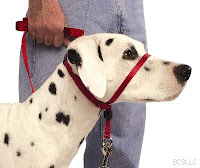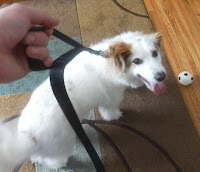Dope on a Rope? Quick Tips for Leash Training
It’s almost comical how often I see dogs dragging their owners in and out of my door. I have this theory that twenty-something men concocted a formula where “manliness” is computed via a dog-to-wife weight ratio. Best of all, the macho husband is usually worse at controlling that monster Great Dane than his tiny, exasperated wife. The humor dies out, though, when you can’t keep the dog from darting into traffic, attacking another animal, or you wind up at your own doc getting rotator cuff surgery. Today’s article will provide tips on keeping Fido under control so everyone stays out of trouble.
The Right Tools for the Job
Controlling your dog on a leash really boils down to training, but the right equipment can make the difference between success and giving up in frustration. Any pet can be trained to behave on any leash or collar. But you can also train to run a 5k on stilts – it’s just a heck of a lot harder. Here are my suggestions for what equipment works, and what you should shy away from.

Gentle Leader (TM) head harness:
These are awesome. One loop goes behind the head, one over the nose, and the leash attaches under the chin. This takes the dog’s mechanical advantage away – it’s no longer using the full force of it’s legs to push that leash snapped on it’s back forward, but instead it’s trying to awkwardly push it’s own head around. Unlike choke/pinch collars, this doesn’t rely on making the dog uncomfortable, though somedo think the slight pressure applied across the bridge of the nose may stimulate pressure points that help them focus, much like mom nipping their nose to get their attention.
Note that the biggest problem folks have with these is not fitting them properly. Most leave them too loose, which is actually more uncomfortable than a tight fit because it allows the loops to slide and rub across the nose, while also reducing your control over the dog. Make sure and buy the one that includes the DVD – watch it, fit it right, and you’ll have a very effective training tool.

Retractable Leashes:
Throw these away. There is no firm, certain boundary with a retractable leash – meaning they train dogs to constantly test their boundaries. Likewise, they train owners not to control their dogs. Buy a short, fixed-length leash. I particularly like the ones with a second handle near the collar to give you firm control when needed – like when passing a pack of yippy, tasty Corgi’s on the sidewalk.
Choke/Pinch Collars:
Many obedience schools will base their programs around them. It’s an old method that can work, and does if you learn it thoroughly (like many folks who run those schools, to be fair). But hardly anyone becomes expert enough after a few classes, and used improperly they have the ability to do harm – unlike a standard collar or harness. Too often I hear dogs gagging in the lobby as they stubbornly forego oxygen to continue dragging their owner around. If you use these, ONLY leave them on the dog when you are attached to the other end and paying attention! They CAN catch them on things and asphyxiate themselves.
Harnesses:
These don’t really provide any advantages or disadvantages for controlling you pet, but they do have the benefit of not encouraging the dog to tug on his own windpipe. They’re a good option for small dogs, where physical control isn’t so much an issue. They are a poor option for large dogs that aren’t well trained, however, as they give the dog that much more leverage.
Training
Who’s in charge? I’m in charge.
The key to training your dog (or child, or spouse) to do anything is rewarding the behavior you want while not rewarding behavior you don’t. In this case we don’t need treats – the reward is being able to keep going forward toward that next wonderfully disgusting odor Rover just has to sniff. At the first tug on the leash, we stop. I’m in charge. No reprimand, no attention, just no movement until they relax, stop pulling, and focus on me. Then we go forward again until they start tugging – and repeat. A gentle, quick tug to refocus them can be useful, but this should not be confused with “jerk on the leash until your dog does what you want.” The goal is to distract from the scent/sight/sound they are focused on back to you. It’s simple, but it takes patience, consistency and a bit of time. The hardest part is being vigilant and consistent. This is a case where bad behavior is its own reward, and allowing them to indulge quickly and powerfully reinforces it. It should also be clear why retractable leashes are so counter-productive; how do you learn what the boundaries are when they keep changing?
Want to train your pet to heal (that is, walk right beside you)? Integrate treats in the training regimen, only giving them when your dog is next to your preferred side. As they get better at staying next to you, be more demanding in your requirements for the reward – only give them when they are EXACTLY where you want, and only if they stay there for a slowly lengthening amount of time. Once they’ve got it dialed in, make it more reliable by only giving treats intermittently.
Just like your kids (or your husband), as soon as you start thinking you’ve almost got them trained and let your guard down a bit they’ll be testing those boundaries hard-core. You must be vigilant. Tugging shall not result in moving forward! Keep at it. You’re in charge. It’s also worth emphasizing the importance of getting them to focus on you before they get rewarded- you are the one providing guidance, instructions, and rewards. Focus doesn’t have to be visual, though – many dogs benefit from staying right up against your leg, quickly learning to read subtle signals in your movements.
As with all training, the right equipment makes things easier – but at the end of the day it boils down to patience, consistency, and work. You can do it – and for any dog over thirty or forty pounds, you really need to do it for everyone’s sake.
